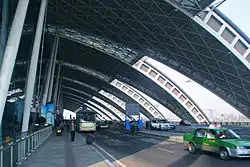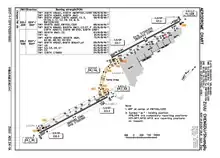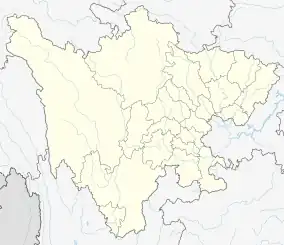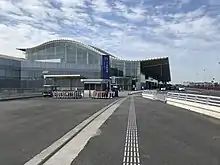Chengdu Shuangliu International Airport
Chengdu Shuangliu International Airport (IATA: CTU, ICAO: ZUUU) is a major air hub of Western China and one of the two international airports serving Chengdu, the capital of China's Sichuan province, the other one being Chengdu Tianfu International Airport (TFU). It mainly serves domestic flights around China.
Chengdu Shuangliu International Airport 成都双流国际机场 | |||||||||||||||
|---|---|---|---|---|---|---|---|---|---|---|---|---|---|---|---|
 | |||||||||||||||
| Summary | |||||||||||||||
| Airport type | Public | ||||||||||||||
| Owner/Operator | Sichuan Provincial Airport Group | ||||||||||||||
| Serves | Chengdu, Sichuan, China | ||||||||||||||
| Location | Shuangliu, Chengdu | ||||||||||||||
| Opened | 1938 | ||||||||||||||
| Hub for | |||||||||||||||
| Elevation AMSL | 495 m / 1,624 ft | ||||||||||||||
| Coordinates | 30°34′42″N 103°56′49″E | ||||||||||||||
| Website | cdairport.com | ||||||||||||||
| Maps | |||||||||||||||
 CAAC airport chart | |||||||||||||||
 CTU Location in Sichuan  CTU Location in China | |||||||||||||||
| Runways | |||||||||||||||
| |||||||||||||||
| Statistics (2021) | |||||||||||||||
| |||||||||||||||
| Chengdu Shuangliu International Airport | |||||||||
|---|---|---|---|---|---|---|---|---|---|
| Simplified Chinese | 成都双流国际机场 | ||||||||
| Traditional Chinese | 成都雙流國際機場 | ||||||||
| |||||||||
Located about 16 kilometres (10 mi) southwest of downtown Chengdu to the north of Shuangliu district, Shuangliu Airport is an important aviation hub for Western China. Shuangliu Airport is one of the two core hubs for Air China, the other being Beijing Capital International Airport. The airport is also the principal hub and headquarters for Sichuan Airlines and Chengdu Airlines. China Eastern Airlines, China Southern Airlines, Shenzhen Airlines, Lucky Air, and Tibet Airlines also have bases at Shuangliu Airport.
Shuangliu Airport was the third-busiest airport in the world and the second-busiest airport in China in 2020.[1]
Overview
History
The airport, formerly named Shuangguisi Airport, opened as an auxiliary military airfield in 1938 during the Second Sino-Japanese War/World War II.[2] At the time, its runway was only large enough for small biplanes. It was also where the Republic of China Air Force Polikarpov I-15 fighters of the 5th Pursuit Group were based for aerial defense of the Chengdu area against Imperial Japanese bomber raids;this following the Chinese retreat from Wuhan to Chungking (now Chongqing) as the new provisional capital in aftermath of the Battle of Wuhan against the Imperial Japanese onslaught. Civilian targets were indiscriminately bombed, and ace fighter pilot of the Chinese Air Force Major Wong Sun-shui, Captain Cen Zeliu and Lieutenant Lin Heng (younger brother of renowned architect and poet Lin Huiyin) flying in their I-15 fighter planes were all killed over Shuangliu air base as a result of battling against the most advanced fighter aircraft of the time; the Mitsubishi A6M "Zero" (Reisen) fighter, in defense of Chengdu on 14 March 1941.[3][4][5][6]
When the U.S. was shocked into World War II with the Pearl Harbor attack, the airport became known as "Shwangliu Airfield" as it was later used by the United States Army Air Forces Fourteenth Air Force as part of the China Defensive Campaign (1942–1945). It was used as a fighter base by the 33d Fighter Group, which flew P-47 Thunderbolt fighter-bombers from the airport in 1944 to support Chinese ground forces, and also by reconnaissance units that operated camera-equipped P-38 Lightnings that located Japanese forces and provided intelligence to the fighter-bombers. The Americans closed their facilities at Shwangliu Airfield at the end of August 1945.[7][8]
On 12 December 1956, the Shuangguisi Airport was put under civil aviation, which was then formally listed as a civil aviation airport and renamed Chengdu Shuangliu Airport. In 1957, the flights of Chengdu civil aviation were shifted to Shuangliu Airport from Guanghan Airport. The flight courses from Chengdu were thus opened to various cities within China including Beijing, Taiyuan, Xi'an, Chongqing, Kunming, Guiyang, and Nanchong.[9] The airport went through several earlier expansions in 1959, 1967, 1983 and 1991 respectively.
Current status
A large-scale expansion was conducted on flight area and navigation area from 1994 to 2001. The runway was extended to 3,600 metres (11,811 ft) with Class 4E rating, allowing for larger jumbo jets including the Boeing 747-400. The newly built terminal building was incorporated with a three-parallel-porch design, accommodating an hourly capacity of 3,500 passengers during rush hours, while the previous terminal building was only designated for regional flights within Sichuan and Chongqing.
The airport is now an international civil airport with flights to more than 50 international destinations and over 170 domestic airports, and is a hub for Chengdu Airlines, Air China and Sichuan Airlines. It is linked to downtown Chengdu by the Airport Expressway, the Chengdu–Mianyang–Leshan intercity railway and the newly built Chengdu Metro line 10 which has stations in both terminals.[10] KLM launched the first intercontinental air route from Chengdu, to Amsterdam, on 28 May 2006.[11]
The construction of its second runway started from late 2008, and service commenced in December 2009. The completed new runway, 3,600 metres (11,811 ft) in length and 60 metres (197 ft) in width, upgraded the previous flight area rating from 4E to 4F, capable of handling the Airbus A380.[12] The new Terminal 2 has started construction in June 2009; trial operations began on 28 July 2012 with limited airlines and was officially opened on 9 August 2012 for all domestic airlines other than Sichuan Airlines. T1 is split into Domestic and International wings, and retained all international flights from airlines within and outside China. The new terminal is twice the size of the current T1, and allows the airport to handle up to 50 million passengers annually.
On 9 June 2014, United Airlines began operating a nonstop service from San Francisco to Chengdu, connecting central China to the United States non-stop for the first time.[13] Service to the US has since expanded, as Hainan Airlines now offers nonstop service from Chengdu to Los Angeles[14] and began nonstop service to New York–JFK in October 2017.[15] In addition, Sichuan Airlines and Air China have many international routes in this airport.
With the opening of Chengdu Tianfu Airport on 27 June 2021,[16] it is planned for most international and cargo routes to be moved away from Shuangliu Airport, which is to mainly operate domestic flights going forward.[17]
Airlines and destinations
Passenger
Other facilities
China Southwest Airlines once had its headquarters on the airport property.[23]
Ground transportation
Airport buses

- Airport Bus No. 1, Chengdu Shuangliu International Airport - City Centre (Minshan Hotel, Section 2 of Renmin Road South, Metro station of Jinjiang Hotel); single ticket: ¥10.
- Airport Bus No. 2, Chengdu Shuangliu International Airport - Chengdu railway station (North Railway Station); single ticket: up to ¥10.
- Airport Bus No. 3, Chengdu Shuangliu International Airport - Chengdu East railway station (Chengdu Dong Railway Station); single ticket: ¥12.
Taxi
It costs about RMB 60 Yuan from Chengdu Shuangliu International Airport to the city centre of Chengdu.

High-speed train (CRH)
Passengers can take the CRH train at Shuangliu Airport railway station to Chengdu South railway station and Chengdu East railway station; single tickets are about ¥11 (US$1.5). The CRH trains at Shuangliu Airport railway station are also bound for Mianyang, Deyang, Meishan Dong (East), Leshan railway and Emeishan railway stations.
Metro
Two stations on Line 10 of the Chengdu Metro links Chengdu Shuangliu International Airport with Taipingyuan station. The stations are Terminal 1 of Shuangliu International Airport station and Terminal 2 of Shuangliu International Airport station which serves Terminals 1 and 2 respectively. It was opened on 6 September 2017.
See also
References
- "These Are the 10 Busiest Airports in the World". Travel + Leisure. Retrieved 19 February 2023.
- Sun, Lianggang. "Shanghai 1937 – Where World War II Began". Shanghai 1937: Where World War II Began. Retrieved 10 December 2020.
When did World War II begin? Shanghai 1937: Where World War II Began answers that question in a way most audiences will find surprising. Americans might say December 7, 1941… The day the Japanese Imperial Navy attacked the American naval base at Pearl Harbor, Hawaii. For Europeans, it was September 1, 1939… When Nazi Germany invaded Poland. But in China, people will tell you a different date. August 13, 1937.
- Song, Wei (宋薇). "Chinese continue to seek justice for Japanese bombings - China - Chinadaily.com.cn".
- 五大隊第十七中隊 林恒. flyingtiger-cacw.com (in Traditional Chinese). Retrieved 14 April 2016.
- "Major 'Buffalo' Wong Sun-Shui". Retrieved 1 June 2015.
- "314 Air Battle over Shuangliu". air.mnd.gov.tw. Retrieved 10 December 2020.
... the ROCAF pilots were in high morale and fighting spirits, they suffered a great loss of 10 planes destroyed and 7 damaged to Japanese new Zeros. PG Cmdr. Huang Xin-rui, Deputy Cmdr. Cen Ze-liu, SQ Cmdr. Chou Lin-xu, Pilot Ren Xian, Pilot Lin Heng, Pilot Jiang Dong-sheng, Pilot Yuan Fang-bing, Pilot Chen Peng-yang were all killed in action.
- Maurer, Maurer. Air Force Combat Units Of World War II. Maxwell Air Force Base, Alabama: Office of Air Force History, 1983. ISBN 0-89201-092-4
- "Air Force History Index -- Search". Retrieved 1 June 2015.
- "www.cdairport.com/cdairport/en_front/airportinfo_a.jsp". Archived from the original on 9 May 2009.
- 15分钟可达双流机场 成都地铁10号线一期9月开通. Sina News (in Chinese (China)). 22 August 2017.
- "KLM to launch scheduled flights between Amsterdam and Chengdu". www.asiatraveltips.com. Retrieved 13 June 2019.
- 四川在线 - 双流机场第二跑道今年国庆节前投入使用. SCOL (in Chinese (China)). 18 March 2009. Archived from the original on 3 March 2016. Retrieved 1 June 2015.
- "For United And The Boeing 787, Chengdu Is Just the Start In China." Forbes. 4 September 2013. Retrieved on 27 February 2014.
- "Hainan Airlines Announces First Ever Nonstop Routes Connecting Los Angeles to Chengdu and Chongqing, China". www.prnewswire.com (Press release).
- "Hainan Airlines plans Chengdu – New York launch in Oct 2017".
- "成都天府国际机场将正式投运 3种方式到天府机场". 26 June 2021.
6月27日,成都天府国际机场将正式投运
- "国际航线全部平移至天府机场 全货机航线分阶段平移至天府机场 现有地区航线可保留在双流机场" [All international routes are shifted to Tianfu Airport. All cargo routes are shifted to Tianfu Airport in stages. Existing regional routes can be kept at Shuangliu Airport.]. e.chengdu.cn. Retrieved 28 June 2021.
- "【新航季来啦~】点击查收南航四川冬春航季运行时刻".
- "2023年新航季川航最新航线出炉,附国际/地区航线新消息". Retrieved 16 March 2023.
- "SF Standard Express (International Services)". SF International. Retrieved 29 June 2023.
- "SF Economy Express (Domestic and Neighbouring Services)". SF International. Retrieved 29 June 2023.
- "SF Airlines commences Shenzhen-Delhi service". CAPA. Retrieved 21 October 2019.
- "World Airline Directory." Flight International. 1–7 April 1998. 57. "Shuangliu Airport, Chengdu, 610202, Sichuan, China"
External links
![]() Media related to Chengdu Shuangliu International Airport at Wikimedia Commons
Media related to Chengdu Shuangliu International Airport at Wikimedia Commons
![]() This article incorporates public domain material from the Air Force Historical Research Agency.
This article incorporates public domain material from the Air Force Historical Research Agency.

.jpg.webp)
.jpg.webp)
.png.webp)